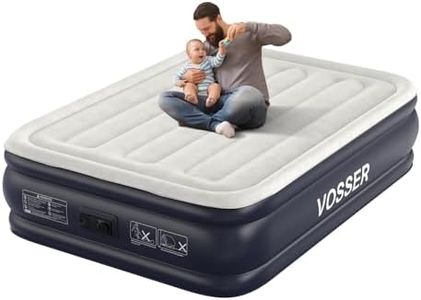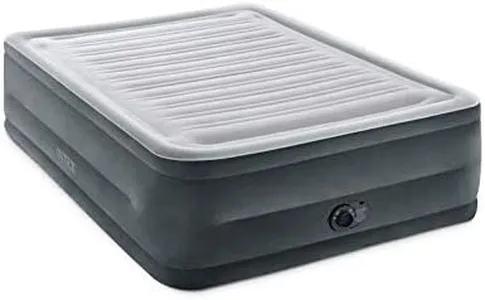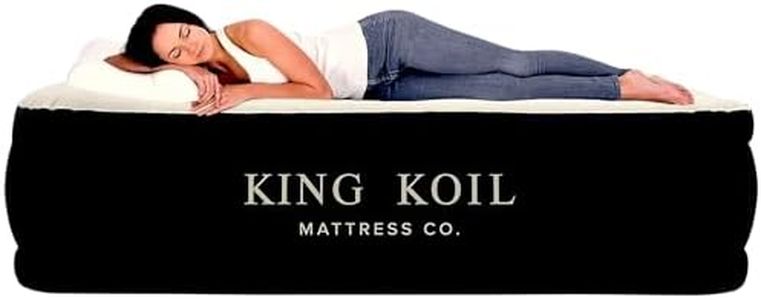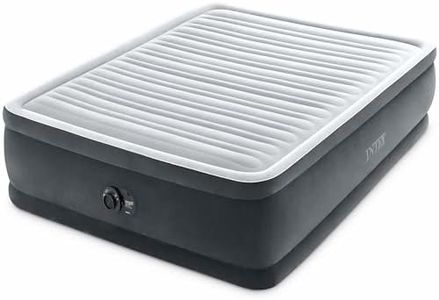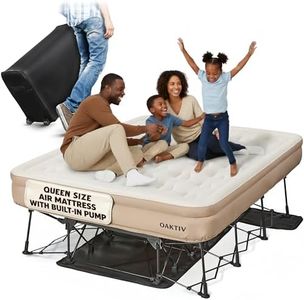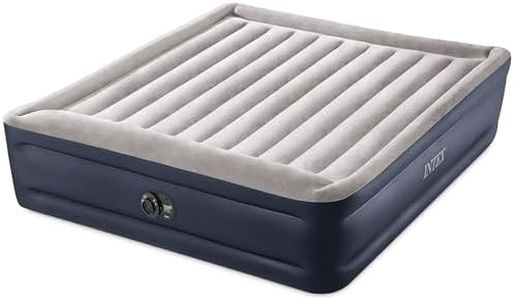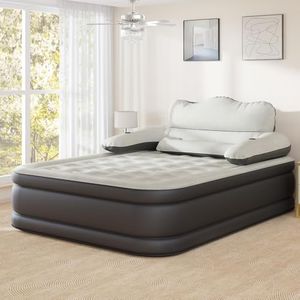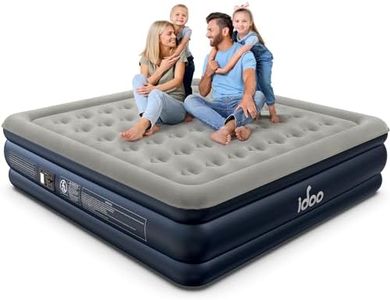10 Best Air Mattresses 2025 in the United States
Our technology thoroughly searches through the online shopping world, reviewing hundreds of sites. We then process and analyze this information, updating in real-time to bring you the latest top-rated products. This way, you always get the best and most current options available.

Our Top Picks
Winner
Intex 64417ED 22in Queen Dura-Beam Comfort Plush High-Rise Inflatable Air Mattress with Built in Pump for Travel and Camping, 600lb Weight Capacity
Most important from
62805 reviews
The Intex 64417ED Dura-Beam Deluxe Comfort-Plush High-Rise Air Mattress is a strong contender in the air mattress category, particularly suitable for travelers, campers, and those needing temporary sleeping solutions for guests. One of its standout features is the built-in electric pump, which allows for quick inflation in about 4.75 minutes, making setup a breeze. The mattress boasts a height of 22 inches, providing a plush feel and making it easier to get in and out of bed.
Comfort is a major highlight, thanks to the unique dual-layer air pocket system and lumbar support that contours to your body. The Fiber-Tech construction enhances durability while keeping the weight manageable at just 19.36 pounds, appealing to those on the go. It also supports a considerable weight capacity of 600 pounds, allowing for a variety of users.
There are a few drawbacks to consider. Some users have reported that during the first inflation, the material stretches, which may be mistaken for a leak. This initial stretching means that the bed may require re-inflation over the first few nights, which could be inconvenient. Additionally, while the mattress is designed to be puncture-resistant, it’s still made of PVC, which may not appeal to eco-conscious consumers. Despite these minor issues, it’s ideal for those seeking a practical, affordable solution for temporary sleeping arrangements, whether at home or in outdoor settings. Plus, the included carry bag and repair patch add to its practicality, making it a versatile option for various lifestyles.
Most important from
62805 reviews
King Koil Luxury Air Mattress Queen with Built in Pump, Integrated Premium Pillow Inflatable Airbed for Guests, Camping & Home (Manufacturer Warranty)
Most important from
55313 reviews
The King Koil Luxury Queen Size Air Mattress stands out in the air mattress category for its comfort and convenience. With a built-in high-speed pump, this mattress inflates in under two minutes, making setup quick and easy, which is a huge plus for both home use and camping. The adjustable firmness feature allows users to customize their sleeping experience, catering to a variety of preferences. The mattress is constructed from durable and puncture-resistant materials, ensuring it can withstand regular use, whether for guests or outdoor adventures.
One of its significant strengths is the 20-inch height, which offers a more traditional bed feel compared to lower models, making it easier to get in and out of bed. It supports a weight capacity of up to 600 pounds, accommodating couples or heavier individuals comfortably. The no-slip base helps maintain stability throughout the night, which is essential for a restful sleep.
However, there are some drawbacks to consider. While the built-in pump is convenient, it relies on a power source, which may be a limitation during camping trips without access to electricity. Some users have reported issues with air retention, indicating that it may require occasional refilling. Additionally, with a weight of nearly 17 pounds, the mattress is not the lightest option available, which could be a factor for those seeking extreme portability.
For those in need of a reliable air mattress for guests, camping, or temporary sleeping arrangements, the King Koil Luxury Queen Size Air Mattress delivers comfort, ease of use, and durability. Just keep in mind the potential power source dependency and weight when planning its use.
Most important from
55313 reviews
Intex Dura-Beam Deluxe Comfort-Plush Elevated: Fiber-Tech – Queen Size – Built-in Electric Pump – 18in Bed Height – 600lb Weight Capacity
Most important from
62805 reviews
The Intex Dura-Beam Deluxe Comfort-Plush Elevated Air Mattress is a queen-size option designed for adults who want a comfortable and supportive sleep surface, especially for camping or guest use. It stands at 18 inches high, which makes it feel more like a regular bed and easier to get on and off. The built-in electric pump inflates the mattress quickly, in about 4 minutes, so you can set it up without hassle. The mattress uses Fiber-Tech construction with thousands of strong polyester fibers, making it more durable and supportive than many basic air mattresses. Its unique edge design helps prevent sagging, offering better support across the whole bed, which is great if you tend to move around during sleep.
With a weight capacity of 600 pounds, it can comfortably hold two adults or one sleeper plus some extra weight from bedding. The surface has a soft, velvety feel that adds comfort and resists punctures and abrasions, although you should still be careful with sharp objects. The mattress material stretches during the first few uses, which can feel like losing pressure—but this is normal and resolves after a couple of nights. Weighing 15 pounds and including a carry bag, it’s fairly portable but not the lightest mattress available, so best suited for car camping or home use rather than backpacking.
If you want a plush, easy-to-inflate queen air mattress with solid durability and good support, the Intex Dura-Beam Deluxe is a strong choice.
Most important from
62805 reviews
Buying Guide for the Best Air Mattresses
Choosing the right air mattress is important for comfort, convenience, and durability, especially if it will be used for guests, camping, or as a temporary bed. The key to making a good purchase is to think about where and how you'll use it most—indoors or outdoors, for short stays or regular use, and how much space and support you need. Focusing on a few important specifications can help you match your needs to the right model.FAQ
Most Popular Categories Right Now
